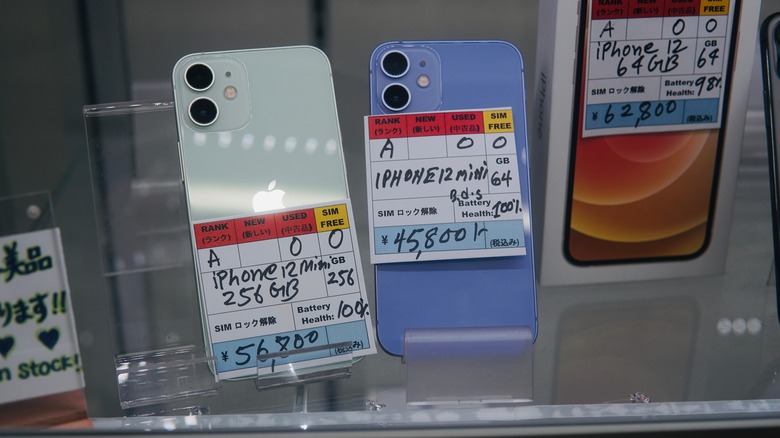
Lokyo Multimedia JP/Shutterstock
By Hiba Fiaz/
Let’s face it: The allure of unboxing a pristine new iPhone is undeniably strong. Apple is notorious for manufacturing products that are sturdy, reliable, and as long-lasting as your grandma’s fruitcake, which is why buying a used device may not come off as such an odd choice. But have you ever thought of the things that could go wrong with buying a secondhand iPhone?
No matter how many Reddit posts, iPhone forums, and online articles arm you with handy information on how to make sure the preloved product you’re buying isn’t a fake, there’s no foolproof way to be wholly and completely certain. Apart from the obvious disadvantages like lack of original warranty and physical attrition, things like internal damage, potential theft, and forced compromise can also ruin your purchase. The only real way to avoid these pitfalls is to buy a brand new phone instead.
Warranty
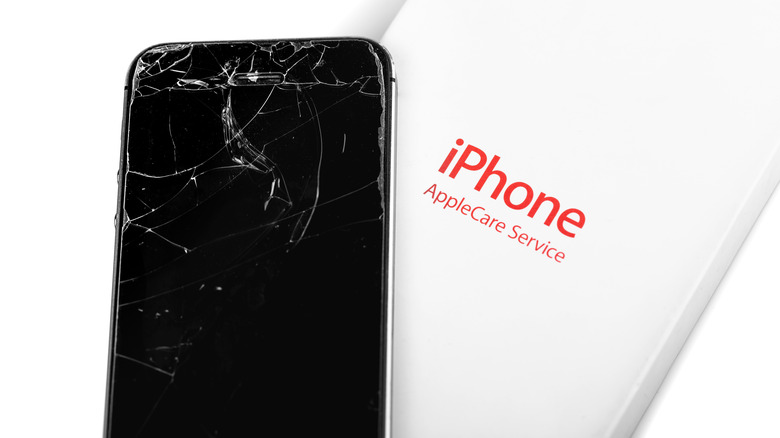
Primakov/Shutterstock
Life is easier when you’re living with the security of a safety net to fall into when things go awry — warranties, insurances, bonds, leases, and so forth. With the uncountable things that could happen to a palm-sized object you use on the daily, the standard one-year warranty (also called AppleCare) that comes with a new iPhone leaves no room for concern. A used device with any other reseller, no matter how authorized or reputable, does not grant you the privilege of an Apple Warranty, though they may provide a local one with entirely different terms and conditions. If the vendor is selling an iPhone that’s less than a year old, you may be lucky enough to get in a few months at most. Not entirely sure about the age of the device? You can always check the Apple Warranty on the iPhone to be sure.
Defects in the camera, bad pixels, faults in the speakers or microphone, and hardware defects are examples of the things included in Apple’s warranty. If your screen begins to glitch or there’s a scratch on the surface of your iPhone out of the box, Apple will cover it for you. However, accidental damage or impairments due to misuse are not included, and this is where we move into our next topic of interest: the AppleCare+.
AppleCare+
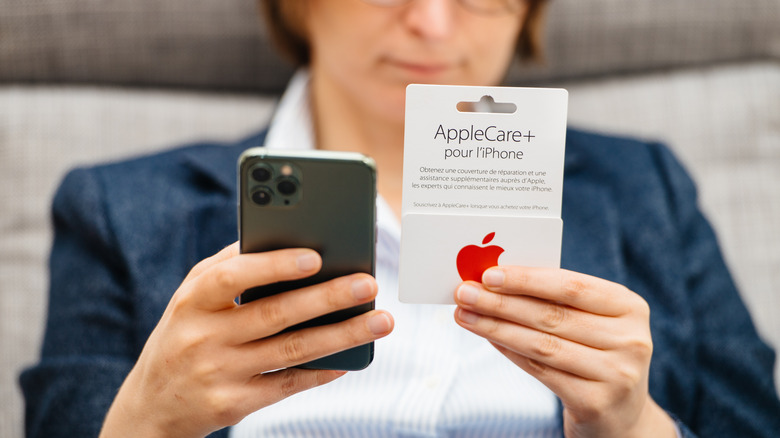
Hadrian/Shutterstock
Phones seem to have this weird knack of finding trouble in the most unexpected ways. Sometimes they slip right through your fingers onto the hard pavement, while other times they plunge into the sink while you shower. Your heart drops as soon as the above events play out — and the second drop comes when your mobile technician tells you the cost required to fix it. Enter AppleCare+, the company’s extended warranty program for all its devices that even covers accidental damage and provides 24/7 technical support. There’s definitely some stuff you should consider before you buy AppleCare+, but it comes with a pretty good list of benefits.
But most importantly folks, is the eligibility. Depending on your region, there’s a limited time period where you can purchase an AppleCare+ plan. It’s 60 days for most countries including the United States, so if the preloved iPhone you’re buying is more than 60 days old, you can’t add in this layer of security. However, if you do buy a used device within its time period and pay an additional price for AppleCare+, the original owner can cancel the plan and get a refund for the remaining days. Watch out people — the secondhand market is getting more cunning by the day.
Battery health
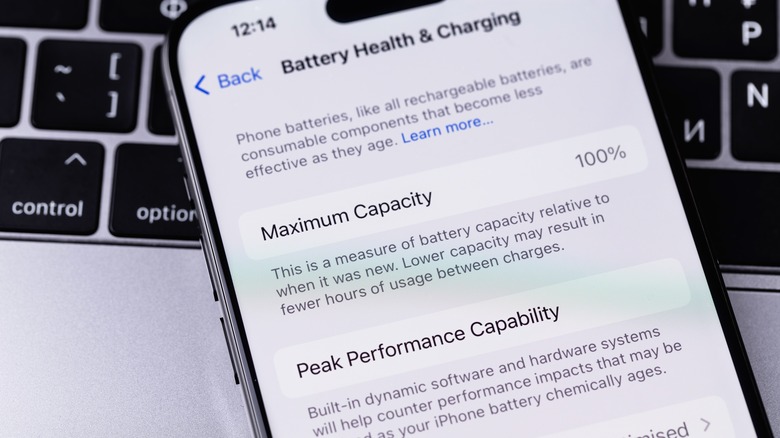
Primakov/Shutterstock
Everyone has varying opinions of what they want in the next iPhone, but a good battery life is unanimously the feature that can make or break its success. Expecting a used iPhone to have 100% battery health is like expecting a dog to talk — as much as you want it to, it’s just not happening. New models, on the other hand, guarantee a pristine start. The farther away you are from that 100% battery health, the greater your chances of experiencing unexplainable shutdowns, shorter charge cycles, and decreased peak performance. How does longer usage play into this, you ask?
All iPhones contain lithium-ion batteries that begin degrading the minute one is manufactured (albeit insignificantly so), but certain factors accelerate this process, like number of charge cycles, environmental temperature, and sun exposure. This is why the way a person uses their iPhone contributes heavily to the condition of the device’s battery, and that’s not something you can figure out before buying a used product. Surprisingly enough, research shows that manufacturing defects and higher discharge rate applications also play a significant role in the iPhone’s notorious reputation of providing sub-par battery life (bringing us back to the perks of an original warranty and AppleCare+ you get with a new model). If you’re considering walking down the pre-loved lane, remember that you might be buying someone’s battery problems instead of a good device. Good thing there’s a simple way to check an iPhone’s battery health, isn’t it?
Cosmetic imperfections
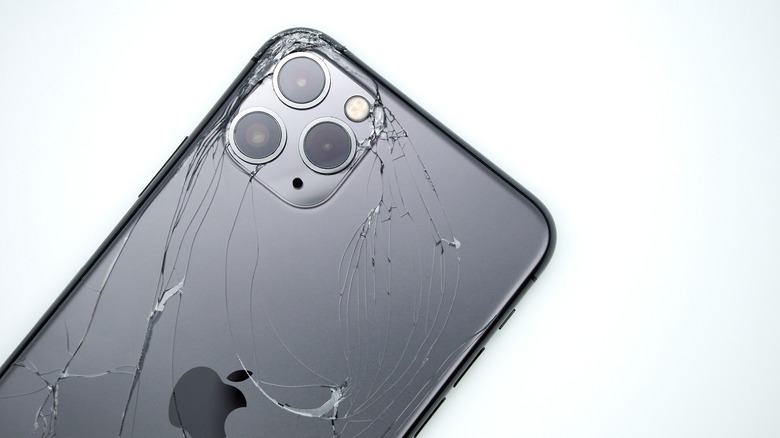
Vlad Kagoshima/Shutterstock
They say you can’t judge a book by its cover. But if the cover in question is a large, jagged crack on the screen, broken shards of aluminum, chipped paint, little dents, or more scuff marks than you can count, then we are — quite bluntly — judging. Normal wear and tear, however, comes hand in hand with a used iPhone, and there’s nothing you can do to mitigate that except doing a thorough examination to ensure the damage is minimal.
Surprisingly, there have been complaints of cosmetic imperfections on brand new iPhones right out of the box too, but those can easily be exchanged through Apple to get your money’s worth, an option you don’t have when buying pre-loved iPhones. If you notice something that bothers you after you’ve bought the device, there’s not much you can do. If you were aware of the physical deformity but find out later that it runs deep enough to hinder performance, there is — once again — very little you can do (unless a local warranty is available to you). First impressions are lasting impressions, and it’s risky to trust an iPhone that looks physically damaged, regardless of how it functions at first.
Counterfeit parts
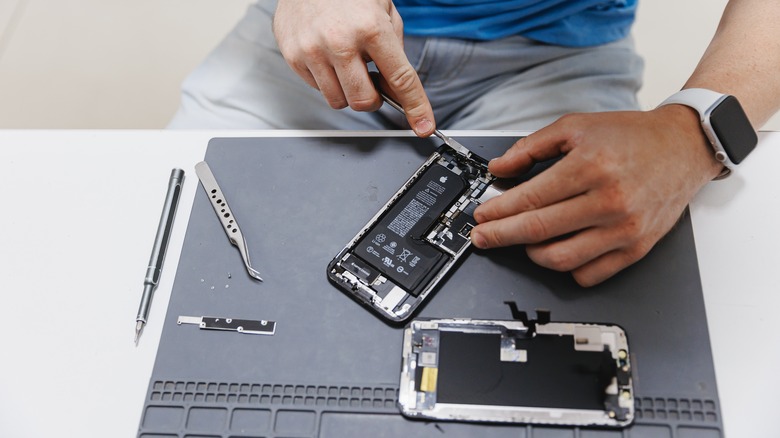
Parilov/Shutterstock
Pulling a fast one on people buying secondhand iPhones has become all too common these days, with scams and rip-offs becoming much more elaborate. With physical imperfections, at least you can see what you’re getting upfront. But what’s on the inside is pretty much a roll of the dice. Your best bet is a quick prayer, crossed fingers, a whole lot of faith, and a few signs your iPhone might have fake parts. People online can be dishonest about getting a part replaced, unauthorized resellers may be offering sealed boxes with counterfeit elements, and online shops may advertise original devices but send ones with fraudulent components. The possibilities are endless, and anyone can look suspicious enough to be taking you for a ride. These devices may work alright for the first few months before mysteriously deteriorating.
There are some ways to figure out if an iPhone has fake components — checking the parts and repair history, examining the Liquid Contact Indicators (LCIs), getting Apple to test it. But you might find out your device is not up to par after the fact. Quality is remembered long after the price is forgotten, and it’s worth paying the few extra bucks for peace of mind. If the price of a pre-loved iPhone sounds too good to be true, it probably is.
Internal damage
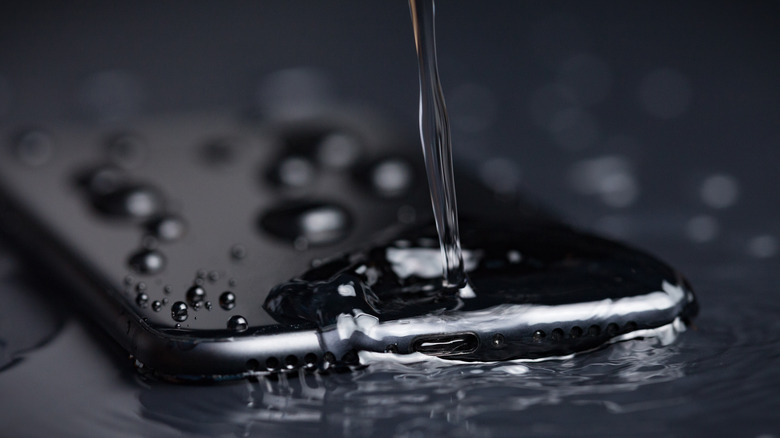
blackzheep/Shutterstock
While we’re on the subject of dissecting an iPhone’s insides, it is worth remembering that replaced components aren’t the only thing to worry about in a secondhand device — any associated internal damage caused by the previous owner can do just as much harm to your phone’s performance and functionality as a counterfeit part. Water damage, impairment of the motherboard, malfunctioning cameras, dislodging of parts due to several hard drops, a spoiled charging port — these are all possibilities.
When these problems persist, there are a few narratives that could play out. The first and most obvious one being that you’re sold a damaged iPhone that seems perfectly capable when first examined, but starts experiencing problems with time. The second scenario plays out when the original owner attempts to fix the damage themselves. Apple notes this can cause safety and functionality concerns if done by an untrained individual, meaning a repaired device isn’t entirely reliable either. You can put lipstick on a pig, but it’s still a pig.
iOS Updates
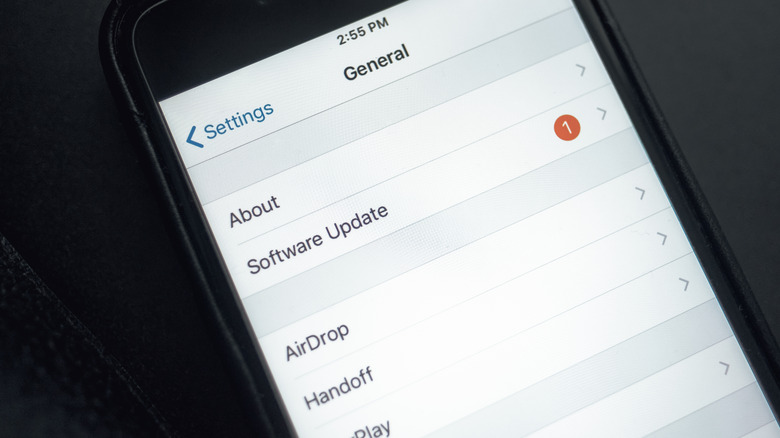
nikkimeel/Shutterstock
According to the Apple Support page, products become vintage when the company stops distribution more than 5 and less than 7 years ago. After 7 years, the products are considered obsolete. Translation: They found a fancier way to tell you your iPhone is old and it’s time to move on. If your device falls into either category, it isn’t eligible for the next iOS update.
Needless to say, a brand new iPhone will give you 5 to 6 years worth of iOS updates, but a used model will fall short of the cut sooner rather than later (if it’s not old enough to be vintage or obsolete already). Live Activities, Dynamic Island, StandBy, the Journal app — these are just a handful of the fantastic features that Apple has released with its iOS updates in the last few years. And you best believe there are many more to come, especially with the announcement of Apple Intelligence on iOS 18.
In short, the magic of using an iPhone is lost if you’re not getting the latest features, and it becomes nothing more than a glorified piece of hardware. Moreover, you may also miss out on security updates and bug fixes that could potentially compromise your safety. Fortunately, old phones are eligible for security updates longer than iOS updates, and vintage devices are still kept in the loop, so you’ll have a couple of years under your belt before you have to worry about it becoming obsolete.
Resale value decreases
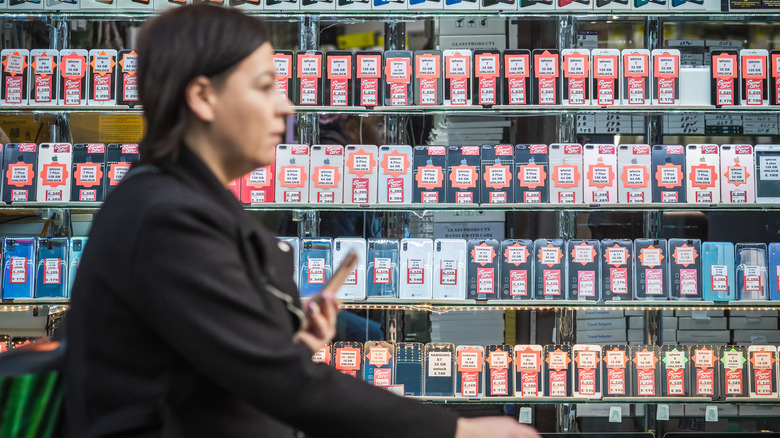
I Wei Huang/Shutterstock
It’s common knowledge that an iPhone maintains its worth better than the other smartphones out there, and people have created entire businesses based on buying and reselling them. In fact, this monetary benefit is sometimes the only reason people buy one. If you snagged a brand new iPhone a few years ago and want to sell it now while it’s still in good shape, chances are it will still fetch a pretty good sum. But that’s not an option when you buy yourself a used model — no one’s lining up to pay top dollar for a device that’s had a good run with two different owners.
Worst case scenario? You pay well for a used iPhone, it works for a few short months or a year before it kicks the bucket, you hunt for cash to get it fixed or try to sell it again, and both are clear dead ends. Best case? It works perfectly well until it goes vintage or obsolete in a couple years, you look to upgrade and gain next to no money when attempting to sell your twice-used device, and you have to start the tedious process of finding another used phone from scratch, with no guarantee that it works out as well as it did before. Either way, you don’t have the security that reselling a new iPhone offers. Selling? Not much return. Upgrading? Start from square one. Repairs? Too much money for no permanent fix.
Compromise on model and color
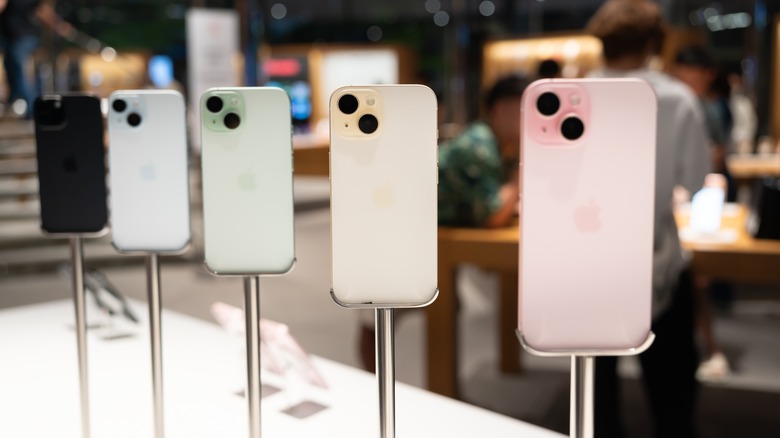
Wongsakorn Napaeng/Shutterstock
When buying a new iPhone, every possible option is available to you. «Legally Blonde» fans can have their shot at living their dreams with the pink iPhone, cinematography fanatics and religious gamers can grab the Pro Max models, and collectors can live in peace with a 1TB storage option. Every color, model, and storage option is at your disposal if your pockets run deep enough to foot the bill, but the same can’t be said when shopping for a used iPhone.
Half a loaf is better than none, and that’s the sort of mindset users usually go with when stepping into the market for a used iPhone. Despite an overflowing assortment of options, a solid secondhand device is hard to come by, and if the price and performance of a find fits their criteria while the color, model, or storage does not, the odds of them waiting around for one that ticks all the boxes is pretty low. This may not seem like a significant compromise to many, but a little thorn on your thumb can be painful too. We’re sure you’re well aware that a sense of wistfulness over what might have been can be hard to overcome. Less or more, old or new, you will still be paying a hefty amount for an iPhone, and it’s only right that you get exactly what you want.
Potential theft
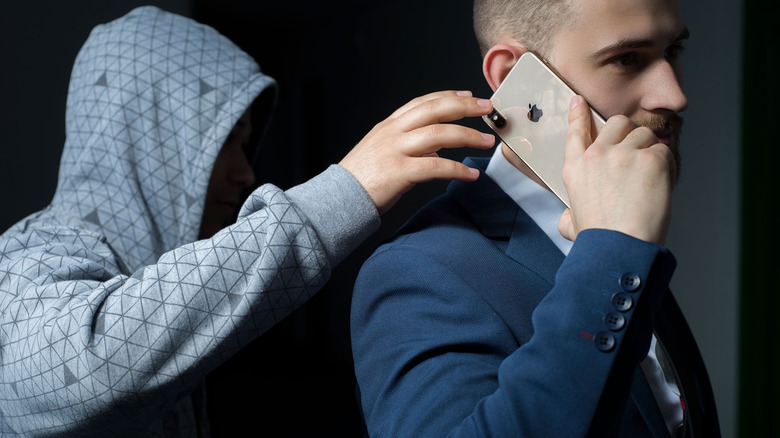
Donenko Oleksii/Shutterstock
Phone theft is an epidemic that hasn’t slowed down. According to the BBC, the London Metropolitan Police reported that 90,864 phones were stolen in London in 2022. If these are the stats for a single city, imagine how hefty the global number is. What happens to these stolen phones is no well-kept secret, with most of them sold off on the black market and eventually ending up in the hands of the average citizen.
There have been far too many cases of folks buying a cheap iPhone off eBay, Craigslist, or an unauthorized store thinking they’d gotten themselves a fair deal, only to find out later that it was stolen and they can’t access it. Unfortunately, there’s no way out of this mess — you’ll have to face the music and live with the money you’ve lost. If a thief has somehow acquired personal information to gain access to the iPhone and sold it off as usable, you might get a call from the authorities claiming the IMEI number of your device has been reported as stolen. Apple has released countermeasures like the stolen device protection feature with iOS 17.3, and it’s essential you know exactly what it is, whether you buy a used iPhone or a new one.